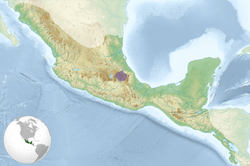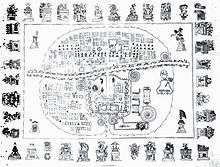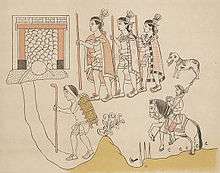Tlaxcala (Nahua state)
Tlaxcala (Classical Nahuatl: Tlaxcallān [tɬaʃ.ˈká.lːaːn̥] "place of maize tortillas") was a pre-Columbian city and state in central Mexico.
Confederacy of Tlaxcala Tlahtōlōyān Tlaxcallan | |||||||||||||||
|---|---|---|---|---|---|---|---|---|---|---|---|---|---|---|---|
| 1348–1520 | |||||||||||||||
 Glyph
| |||||||||||||||
 Tlaxcala during the conquest | |||||||||||||||
| Capital | Tlaxcala | ||||||||||||||
| Common languages | Official language: Nahuatl | ||||||||||||||
| Religion | Aztec religion | ||||||||||||||
| Government | Confederation | ||||||||||||||
| Tlatoani of Tlaxcala | |||||||||||||||
• 1348 | Culhuatecuhtli | ||||||||||||||
| Historical era | Post Classic /Early Modern | ||||||||||||||
• The Tlaxcalla People Migrate to Central Mexico | 1348 | ||||||||||||||
| 1520 | |||||||||||||||
| Population | |||||||||||||||
• 1348 | ? | ||||||||||||||
• early 15th century | 650,000 | ||||||||||||||
• 1519 | 300,000 | ||||||||||||||
| Currency | Quachtli, Cacao | ||||||||||||||
| |||||||||||||||
| Today part of | |||||||||||||||
During the Spanish conquest of the Aztec Empire, Tlaxcala allied with the Spaniards against the Aztecs, supplying a large contingent for – and at times the majority of – the Spanish-led army that eventually destroyed the Aztec empire.
History

The top-right hand sector is Tizatlan, the bottom-right hand sector Quiahuiztlan, the top-left hand sector Ocotelolco, and the bottom-left hand sector Tepeticpac. The river, Atzompa, crosses the city from north to south (left to right, the map being oriented along an east–west axis). From Alfredo Chavero, Pintures Jeroglificas, Mexico 1901.

The Tlaxcalans arrived in Central Mexico during the Late Postclassic. They first settled near Texcoco in the valley of Mexico, between the settlement of Cohuatlinchan and the shore of Lake Texcoco.[1] After some years the Tlaxcallans were driven out of the valley of Mexico and moved to the east, splitting into three groups along the way. While one group continued north towards the modern state of Hidalgo and another remained in the vicinity of Texcoco, a third group arrived to the modern valley of Tlaxcala, where they established the city of Tepetícpac Texcallan under the leadership of Culhuatecuhtli Quanex.
Over the subsequent years, the Tlaxcallan state expanded with the foundations of Ocotelulco and Tizatlán. The fourth major settlement, Quiahuiztlan, was founded by members of the Tlaxcallan group that had initially remained in the valley of Mexico.[1]
Ancient Tlaxcala was a republic ruled by a council of between 50 and 200 chief political officials (teuctli [sg.], teteuctin [pl.]) (Fargher et al. 2010). These officials gained their positions through service to the state, usually in warfare, and as a result came from both the noble (pilli) and commoner (macehualli) classes.
Tlaxcala was never conquered by the Aztec empire, but was engaged in a state of perpetual war, the so-called flower wars or garland wars.
Conquistador Bernal Díaz del Castillo describes the first battle between the Spanish force and the Tlaxcalteca as surprisingly difficult. He writes that they probably would not have survived, had not Xicotencatl the Elder, and Maxixcatzin, persuaded Xicotencatl the Younger - the Tlaxcallan warleader - that it would be better to ally with the newcomers than to kill them.[2]:140–188
Xicohtencatl the Younger was later condemned by the Tlaxcaltecan ruling council and hanged by Cortés for desertion in April 1521 during the siege of Tenochtitlan.
As a result of their alliance with the Spaniards, Tlaxcala had hidalgo privileged status within Spanish colonial Mexico. After the Spanish conquered Tenochtitlan and the rest of Mexico, Tlaxcala was allowed to survive and preserve its pre-Columbian culture. In addition, as a reward to the Tlaxcalans unyielding loyalty to the Spanish, the city and its inhabitants largely escaped the pillaging and destruction following the Spanish conquest.
Due to protracted warfare between the Aztecs and the Tlaxcala, the Tlaxcala were eager to exact revenge, and soon became loyal allies of the Spanish. Even after the Spanish were expelled from Tenochtitlan, the Tlaxcala continued to support their conquest. Tlaxcala also assisted the Spanish in the conquest of Guatemala.[3]
Following the Spanish Conquest, Tlaxcala was divided into four fiefdoms (señoríos) by the Spanish corregidor Gómez de Santillán in 1545 (26 years after the Conquest). These fiefdoms were Ocotelolco, Quiahuiztlan, Tepeticpac, and Tizatlan. At this time, four great houses or lineages emerged and claimed hereditary rights to each fiefdom and created fictitious genealogies extending back into the pre-Columbian era to justify their claims.[4]
During the colonial period, the Tlaxcalan people were regarded as being of higher status and received better treatment compared to the other indigenous peoples of New Spain. However, the indigenous population who had been living in Tlaxcala were reduced to a small minority. According to the Catholic Encyclopedia, in 1625 the city of Tlaxcala had only 700 people, compared to a population of 300,000 a century earlier, owing to epidemics, emigrations, and the work of digging the canal of Nochistongo to drain the Valley of Mexico.[5]
See also
- Tlaxcaltec - Nahuatl for inhabitants of Tlaxcala
- Tlaxcala - the present day Mexican state
- Tlaxcala, Tlaxcala - the present day capital of the state of Tlaxcala
References
- Aurelio López Corral; et al. (2016). "La República de Tlaxcallan". Arqueología Mexicana. 139: 42–53.
- Diaz, B., 1963, The Conquest of New Spain, London: Penguin Books, ISBN 0140441239
- Restall and Asselbergs 2007, pp. 79–81.
- Gibson, 1952.
- "Tlaxcala". New Advent Catholic Encyclopedia. Retrieved March 11, 2012.
Sources
- Diego Muñoz Camargo's History of Tlaxcala (Lienzo de Tlaxcala), written in or before 1585, is an illustrated codex describing the conquest of Mexico. It was painted by Tlaxcalteca artists under Spanish supervision.
- Crónica Mexicayotl was written by Fernando Alvarado Tezozomoc, in Nahuatl and Spanish, in the last decades of the 16th century.
Bibliography
- Alvarado Tezozomoc, Fernando (1944). Crónica Mexicana. Mexico: Manuel Orozco y Berra, Leyenda.
- Fargher, Lane F., Richard E. Blanton and Verenice Y. Heredia Espinoza (2010). Egalitarian Ideology and Political Power in Prehispanic Central Mexico: The Case of Tlaxcallan. "Latin American Antiquity," 21(3):227-251.
- Gibson, Charles (1952). Tlaxcala in the Sixteenth Century. New Haven: Yale University Press.
- Hassig, Ross (2001). "Xicotencatl: rethinking an indigenous Mexican hero", Estudios de Cultura Nahuatl, UNAM.
- Hicks, Frederic (2009). Land and Succession in the Indigenous Noble Houses of Sixteenth-Century Tlaxcala. Ethnohistory, 56:4, 569–588.
- Muñoz Camargo, Diego (1982) [1892]. Historia de Tlaxcala. Alfredo Chavero. México.
- Restall, Matthew; Florine Asselbergs (2007). Invading Guatemala: Spanish, Nahua, and Maya Accounts of the Conquest Wars. University Park, Pennsylvania, USA: Pennsylvania State University Press. ISBN 978-0-271-02758-6. OCLC 165478850.